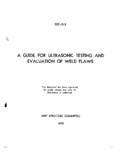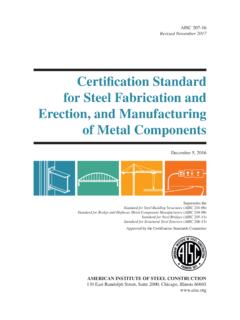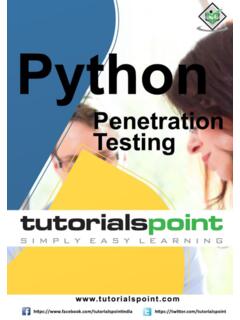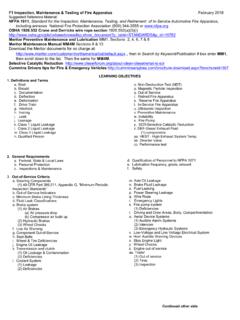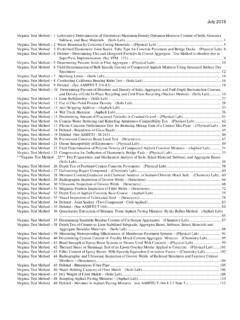Transcription of Standard Practice for Liquid Penetrant Examination
1 Designation: E 1417 99An American National StandardStandard Practice forLiquid Penetrant Examination1 This Standard is issued under the fixed designation E 1417; the number immediately following the designation indicates the year oforiginal adoption or, in the case of revision, the year of last revision. A number in parentheses indicates the year of last reapproval. Asuperscript epsilon (e) indicates an editorial change since the last revision or This Practice establishes the minimum requirements forconducting Liquid Penetrant Examination of nonporous metal,and nonmetal The Penetrant Examination processes described in thispractice are applicable to in-process, final, and maintenance(in-service) inspections.
2 These processes are applicable for thedetection of discontinuities, such as lack of fusion, corrosion,cracks, laps, cold shuts, and porosity, that are open or con-nected to the surface of the component under Caution must be exercised in the usage of elevatedtemperature with components manufactured from thermoplas-tic materials. Also, some cleaners, penetrants, and developerscan have a deleterious effect on nonmetallic materials such asplastics. Prior to Examination , tests should be conducted toensure that none of the cleaning or inspection materials areharmful to the components to be The values stated in inch-pound units are regarded asstandard.
3 The SI units given in parentheses are for All areas of this Practice may be open to agreementbetween the cognizant engineering organization and the sup-plier, or specific direction from the cognizant Standard does not purport to address all of thesafety concerns, if any, associated with its use. It is theresponsibility of the user of this Standard to establish appro-priate safety and health practices and determine the applica-bility of regulatory limitations prior to precau-tionary statements are given in Notes 2 and Referenced The following documents form a part of this Practice tothe extent specified standards .
4 D 95 Test Method for Water in Petroleum Products andBituminous Materials by Distillation2D 2512 Test Method for Compatibility of Materials withLiquid Oxygen (Impact Sensitivity Threshold and Pass-Fail Technique)3E 165 Test Method for Liquid Penetrant Examination4E 543 Practice for Evaluating Agencies that Perform Non-destructive Testing4E 1135 Test Method for Comparing the Brightness of Fluo-rescent Penetrants4E 1316 Terminology for nondestructive DocumentANSI/ASNT-CP-189 Standard for Qualification and Certi-fication of nondestructive testing Personnel5 SNT-TC-1A Recommended Practice for Personnel Qualifi-cation and Certification in nondestructive standards .
5 6 MIL-I-25135 Inspection Materials, Penetrant7 QPL 25135 Qualified Products of, Inspection Materials,Penetrant7 MIL-STD-410 nondestructive testing Personnel Qualifica-tion and Certification7 MIL-STD-792 Identification Marking Requirements forSpecial Purpose Components7 MIL-STD-1907 Liquid Penetrant and Magnetic Particle,Soundness Requirements for Materials, Parts, and Weld-ments7 MIL-STD-2175 Castings Classification and Inspection of7 QPL-AMS-2644 Qualified Products List, Inspection Mate-rial, Penetrant7 MIL-STD-6866 Inspection, Penetrant Method of7 MIL-STD-45662 Calibration System standards :8 ANSI/NCSL Z540-1 General Requirement for CalibrationLaboratories and Measuring Test EquipmentISO 10012-1 Quality Assurance Requirements for Measur-ing Test EquipmentNAS 410 Certification and Qualification of NondestructiveTest Personnel1 This Practice is under the jurisdiction of ASTM Committee E-7 on Nonde-structive testing and is the direct responsibility of Subcommittee on LiquidPenetrant and Magnetic Particle edition approved Feb.
6 10, 1999. Published April 1999. Originallypublished as E 1417 91. Last previous edition E 1417 Book of ASTM standards , Vol Book of ASTM standards , Vol Book of ASTM standards , Vol from American Society for nondestructive testing , 1711 ArlingatePlaza, Box 28518, Columbus, OH of specifications, standards , drawings, and publications required bymanufacturers in connection with specific acquisition functions should be obtainedfrom the contracting activity or as directed by the contracting from Standardization Documents Order Desk, Bldg. 4 Section D, 700 Robbins Ave., Philadelphia, PA 19111-5094, Attn: from American National standards Institute, 11 West 42ndStreet, 13thFloor, New York, NY SOCIETY FOR testing AND MATERIALS100 Barr Harbor Dr.
7 , West Conshohocken, PA 19428 Reprinted from the Annual Book of ASTM standards . Copyright Standard :9 AMS 2644 Inspection Material, Contracts Unless otherwise specified, the issuesof the documents that are DoD adopted are those listed in theissue of the DoDISS (Department of Defense Index of Speci-fications and standards ) cited in the of Precedence In the event of conflict betweenthe text of this Practice and the references cited herein, the textof this Practice takes The terminology relating to Liquid Penetrant examina-tion that appears in Terminology E 1316 shall apply to theterms used in this of Terms Specific to This any component that will be installed on asystem that engineering organization the company,agency, or other authority responsible for the design or afterdelivery, end use of the system or component for which liquidpenetrant Examination is required.
8 In addition to design per-sonnel, this may include personnel from material, and processengineering, stress analysis, NDT or quality groups and others,as the part(s) or element(s) of a systemdescribed, assembled, or processed to the extent specified bythe Examination the final Examination performedfor the acceptance of the item. Any change to the item s surfacesuch as machining, grinding, welding, heat treatment, oretching by subsequent manufacturing operation, may renderthe previous Examination invalid, requiring reexamination ofall affected surfaces, unless otherwise approved in the that which occurs during manufacturingbefore a component is in final refers to components that are in use orstorage for their intended indication Penetrant indications with at least athree to one length to width repeat, after cleaning, the application andappropriate processing of Penetrant .
9 Emulsifier (as required),and developer (as required). indication Penetrant indication whoselength to width ratio is less than the organization contracted to supply thematerial, parts, or engine critical components any componenton turbine engine designated by the manufacturer as critical. 4. Significance and This Practice establishes the basic parameters for con-trolling the application of the Liquid Penetrant method. Thispractice is written so it can be specified on the engineeringdrawing, specification, or contract. It is not a detailed how-toprocedure to be used by the inspector and, therefore, must besupplemented by a detailed procedure that conforms to therequirements of this Practice .
10 Test Method E 165 containsinformation to help develop detailed how-to Penetrant Examination processes and materials are clas-sified in accordance with the material classification containedin MIL-I-25135 or AMS 2644. Penetrant systems covered bythis Practice shall be of the following types, methods, andsensitivity I Fluorescent II Visible A Water B Post-emulsifiable, C D Post-emulsifiable, (These levels apply to Type I penetrantsystems only. Type II Penetrant systems have only a singlesensitivity and it is not represented by any of the levels listedas follows) Level1 2 Very Level 1 Level 2 Level 3 Level 4 Developers shall be of the following a Dry b c d Nonaqueous for Type I fluorescent e Nonaqueous for Type II visible f Specific Solvent removers shall be of the following 1 2 3 Specific General for Examination Unless otherwisespecified in the contract or purchase order, the cognizantengineering organization is responsible for the performance ofall Examination requirements as specified herein.



